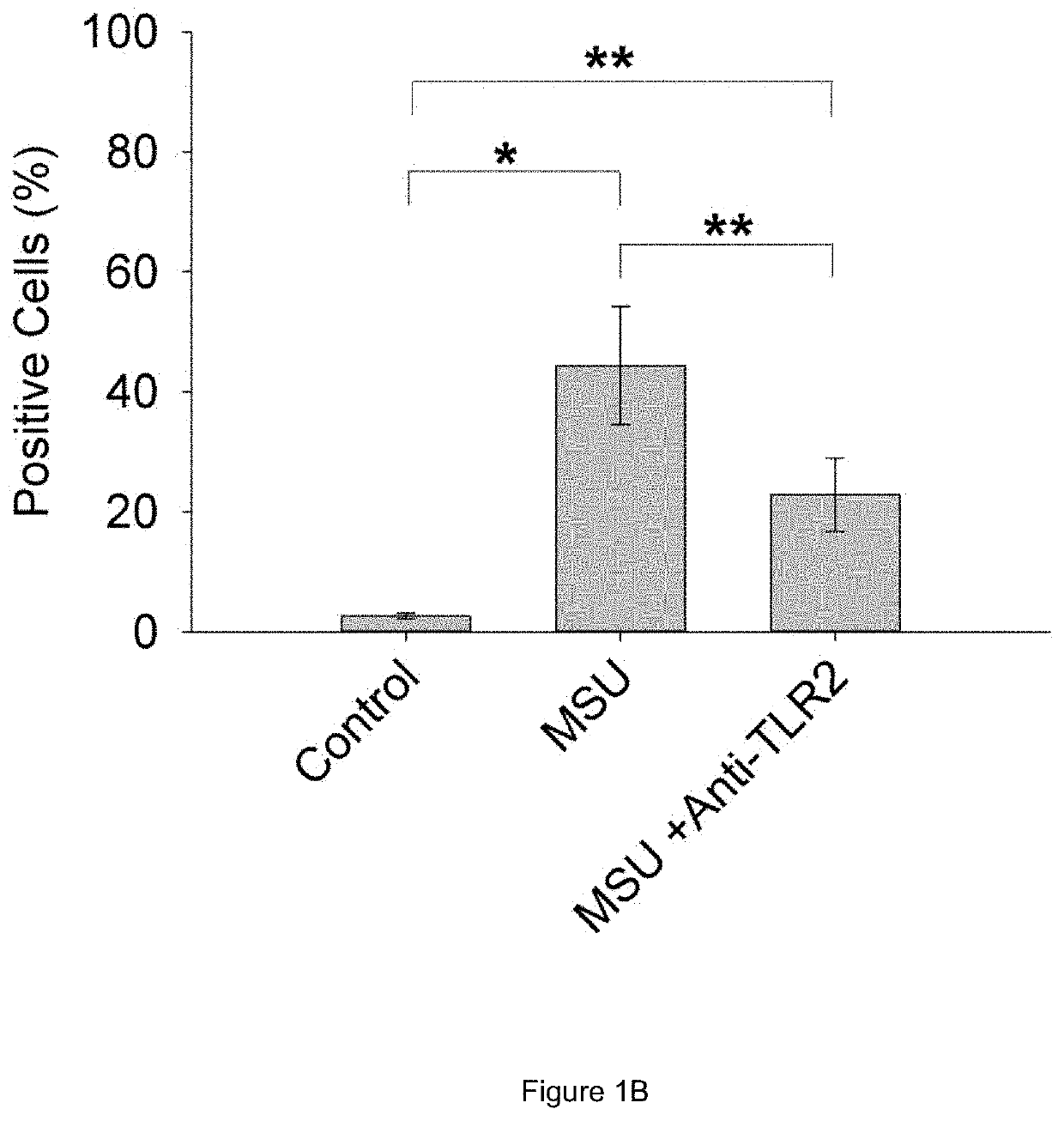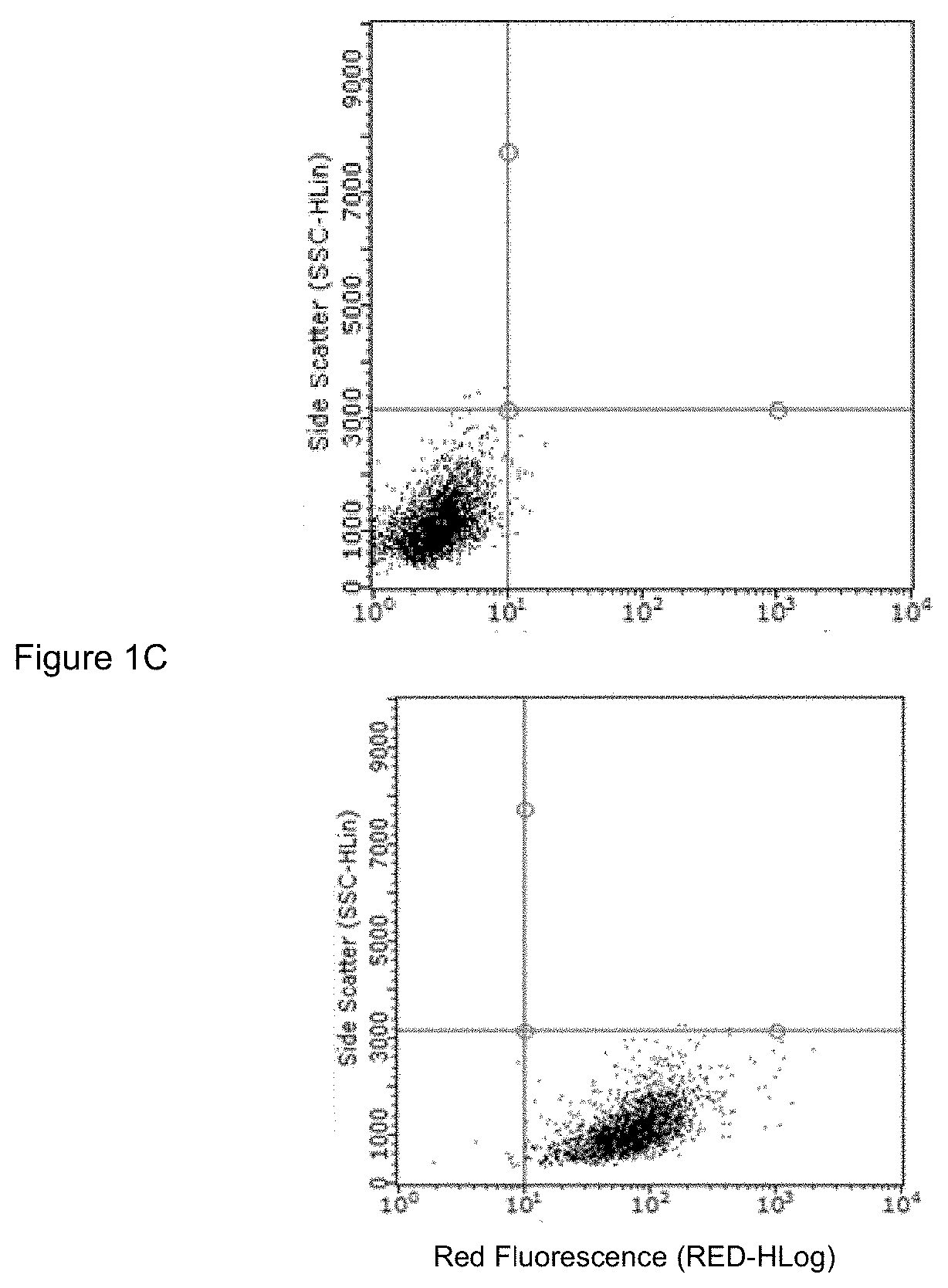Prg-4 for treating gout and its symptoms
a technology for gout and its symptoms, applied in the field of gout treatment and the symptoms of gout, can solve the problems of increased blood sugar, ulcers, and ulcers, and drugs carry the risk of stomach pain, bleeding ulcers, and ulcers, and achieve the effects of reducing inflammation, reducing pain, and increasing dosag
- Summary
- Abstract
- Description
- Claims
- Application Information
AI Technical Summary
Benefits of technology
Problems solved by technology
Method used
Image
Examples
example 1
t of Anti-TLR2 Antibody and rhPRG4 Treatment on MSU Phagocytosis by THP-1 Macrophages
[0063]Differentiation of THP-1 monocytes (ATCC, USA) into macrophages was performed as previously described (Park E K et al., Inflamm Res 2007; 56:45-50.). A THP-1 monocyte cell line was obtained from American Type Culture Collection (ATCC, USA). Cells were cultured to a density of 1.5×106 cells / mL in 75 cm flask in RPMI 1640 medium supplemented with 10% heat-inactivated fetal bovine serum (FBS), 10 mM HEPES, 2 mM glutamine, 100 U / L Penicillin and 100 μg / ml streptomycin and maintained at 37° C. under 5% CO2. In sterile 12 well plates (Corning, Sigma Aldrich, USA), 500,000 cells in 2 ml RPMI 1640 media were differentiated into macrophages by incubation with phorbol 12-myristate-13-acetate (PMA; Sigma Aldrich) to a final concentration of 5 ng / ml for 48 hours. Subsequently, media supernatants were removed and wells were washed three times with sterile PBS to remove any unattached cells and new RPMI 164...
example 2
rhPRG4 Treatment on MSU-Induced Pro-Inflammatory Cytokines and Chemokines Gene Expression in THP-1 Macrophages
[0068]Following differentiation of THP-1 monocytes, macrophages were treated with MSU (100 μg / mL) in the absence or presence of rhPRG4 (25, 50, 100 and 200 μg / mL) for 24 hours. Following treatment, total RNA was extracted using trizol reagent (Thermo Fisher Scientific), and RNA concentrations were determined with a NanoDrop ND-2000 spectrophotometer (NanoDrop Technologies, USA). cDNA was synthesized using Transcriptor First Strand cDNA Synthesis Kit (Roche, USA). Quantitative PCR (qPCR) was performed on Applied Biosystems Step One Plus Real-Time PCR System (Thermo Fisher Scientific, USA) using TaqMan Fast Advanced Master Mix (Life Technologies, USA). The genes of interest included IL-1β (Hs00174097_m1, ThermoFisher Scientific), TNF-α (Hs01113624_g1, ThermoFisher Scientific), MCP-1 (Hs00234140_m1, ThermoFisher Scientific) and IL-8 (Hs00174103_m1, ThermoFisher Scientific). The...
example 3
rhPRG4 Treatment on MSU-Induced Pro-Inflammatory Cytokines and Chemokines Production by THP-1 Macrophages
[0070]Following differentiation of THP-1 monocytes, macrophages were treated with MSU (100 μg / mL) in the absence or presence of rhPRG4 (100 and 200 μg / mL) for 24 hours. Subsequently, media supernatants were collected and media concentrations of IL-β, TNF-α, MCP-1 and IL-8 were determined using commercially-available ELISA kits (R&D Systems, USA). Data is presented as Percent of cytokine and chemokine concentration in the untreated control macrophages. Data represents the mean±S.D. of 3 independent experiments with duplicate wells per group.
[0071]Results show that rhPRG4 treatment inhibits MSU-induced IL-β, TNF-α, MCP-1 and IL-8 production by THP-1 macrophages. Pro-inflammatory cytokines and chemokines concentrations in media supernatants from untreated macrophages and MSU-treated macrophages in the absence or presence of rhPRG4 is shown in FIG. 3. Treatment with MSU crystals incr...
PUM
| Property | Measurement | Unit |
|---|---|---|
| concentration | aaaaa | aaaaa |
| concentration | aaaaa | aaaaa |
| concentration | aaaaa | aaaaa |
Abstract
Description
Claims
Application Information
 Login to View More
Login to View More - R&D
- Intellectual Property
- Life Sciences
- Materials
- Tech Scout
- Unparalleled Data Quality
- Higher Quality Content
- 60% Fewer Hallucinations
Browse by: Latest US Patents, China's latest patents, Technical Efficacy Thesaurus, Application Domain, Technology Topic, Popular Technical Reports.
© 2025 PatSnap. All rights reserved.Legal|Privacy policy|Modern Slavery Act Transparency Statement|Sitemap|About US| Contact US: help@patsnap.com



